Contents
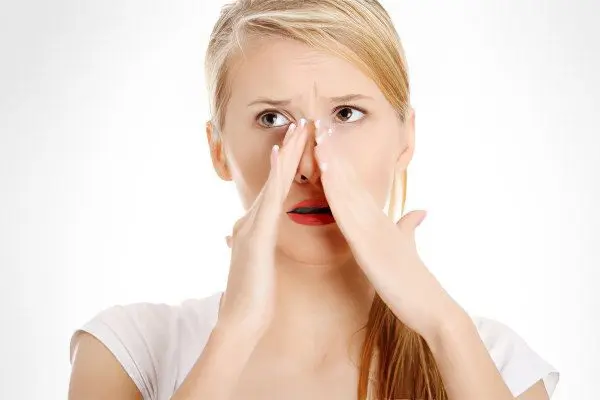
Nose pain never occurs on its own. This feeling always indicates a certain disease or disorder in the body. Depending on the degree of its severity, a person needs emergency or planned medical care. Nose pain should not be ignored, it is important to find out the cause of its occurrence. If it appears against the background of rhinitis, then you should not hesitate to contact the doctor.
Inflammation inside the nose will be indicated by the pain that a person has on inspiration. Separately painful sensations occur extremely rarely. Most often they are accompanied by itching, burning, inflammatory reaction. Sometimes pain indicates the formation of a tumor neoplasm (both malignant and benign). Only a doctor can find out the exact cause of pain.
What structures can become inflamed in the nose?
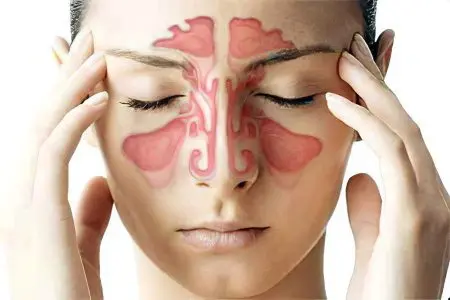
It is the inflammatory process that most often leads to pain in the nose. Almost any part of the body can be affected. Many diseases are accompanied by simultaneous inflammation of several nasal structures at once.
A pathological reaction can spread to such areas of the nose as:
Skin and subcutaneous tissue.
cartilage tissue.
Bone structures.
Mucous membrane.
Vessels.
Nerve fibres.
Paranasal sinuses.
Nasopharynx.
Diseases that cause pain in the nose
Pathologies that can provoke pain in the nose:
Various infections: tuberculosis or syphilis of the nose, boils, measles, etc.
Cancer neoplasms.
Nose injuries.
Neurological pathologies: Charlin’s syndrome, Slader’s syndrome.
Diseases with an unspecified etiological factor: eczema, Wegener’s granulomatosis.
Many infectious processes can become chronic, causing constant pain. During the remission period, discomfort will be barely noticeable. When exacerbated, it is greatly enhanced.
Often structures located near the nose, such as the sinuses, are involved in the pathological process. This picture is typical for polysinusitis.
Causes and symptoms of nose pain
There are various diseases that can lead to pain in the nose.
Rhinitis

Rhinitis or runny nose most often causes not pain, but discomfort. With this problem, a person has abundant discharge from the nose, his mucous membranes become inflamed. The disease has an acute course and responds well to therapy.
The cause of inflammation is viruses and bacteria that enter the nasal mucosa. By itself, rhinitis does not cause pain, but when a person begins to blow his nose, the irritation intensifies, which means that discomfort increases. It also occurs due to frequent friction of the wings of the nose.
If allergens become the cause of rhinitis, then itching and burning occurs in the nose. The person complains of lacrimation and headache. A wide variety of substances can act as allergens, ranging from house dust and animal hair to food. To cope with such a violation, you will need to eliminate contact with the allergen.
Rhinitis is treated by an otolaryngologist. By itself, a runny nose does not pose a serious threat to health. However, if you do not get rid of it in time, then it can lead to serious complications. So, chronic rhinitis often causes sinusitis (inflammation of one or several paranasal sinuses).
More: Runny nose – causes and symptoms, how and how to treat? ➤
Sinusitis
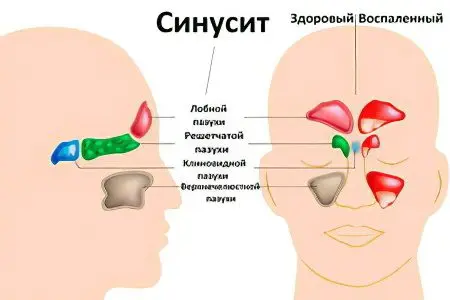
Sinusitis is an inflammatory reaction centered in the sinuses. Most often, the causes of sinusitis are: allergic rhinitis, infectious diseases of the ENT organs of viral or microbial origin, colds.
If sinusitis is left untreated, then all paranasal sinuses will be involved in the inflammatory process. This will lead to the development of pansinusitis.
The main symptom of sinusitis is pain. It intensifies when pressure is applied to the tip of the nose, it often radiates to the bridge of the nose, to the face, to the back of the head, etc. Other symptoms of sinusitis depend on where exactly the pathological process is concentrated. If inflammation develops in the maxillary sinuses, then the pain is localized on the sides of the wings of the nose, on both sides. Frontitis is characterized by painful sensations in the region of the nose. With ethmoiditis, pain occurs under the eyes, and with sphenoiditis, in the region of the skull.
More: Sinusitis in adults – causes, symptoms, how to treat? ➤
Furuncle
A furuncle is a bulge that rises above the surface of the skin or mucous membranes. Such an abscess is painful. Most often it is formed in the region of the tip of the nose, or in its vestibule.
A furuncle occurs due to infection in the sebaceous gland, or in the hair follicle. The reproduction of pathogenic flora leads to inflammation and suppuration. Most often, boils are provoked by staphylococci and streptococci.
Nose injury

Any, even a minor injury to the nose, leads to severe pain. The most common injury is a bruise and a blow. Mostly children get such damage during active games.
The nose can be injured by a foreign object that the child places in the nostril. Therefore, parents need to pay attention to children’s complaints of pain in the nose.
Minor injuries cause minor pain. It quickly passes, and the tissues are restored. If a person has a fracture of the nasal septum or other severe damage, then the pain will be very severe.
In addition to pain against the background of a fracture, edema develops, a hematoma forms. Thermal and chemical damage to the nose leads to acute pain.
Regardless of the type of injury, the person who received it needs to go to the hospital.
Neoplasms of the nasal cavity
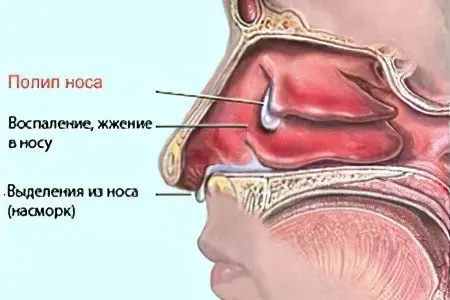
Regardless of whether a tumor grows in a person’s nose – benign or malignant, in the early stages of its development there will be no pain. It occurs after the tumor begins to put pressure on the nerve fibers and tissues located nearby. Even this pain can remain insignificant for a long time, so the person will not seek medical help. This leads to the fact that the tumor is detected at the moment when it reaches an impressive size.
Cysts growing in the nose are often suppurated. Also, pain will occur due to the decay and necrosis of tissues. Nasal polyps are painful.
The main danger of malignant tumors is their asymptomatic development. A person begins to experience discomfort when the tumor reaches an impressive size. In addition to pain, purulent discharge appears, from which it smells unpleasant. The sense of smell worsens. Discomfort often focuses not only in the nose, but also in the upper part of the head, in the face. This indicates that the tumor began to put pressure on the nerve fibers.
Tuberculosis of the nose
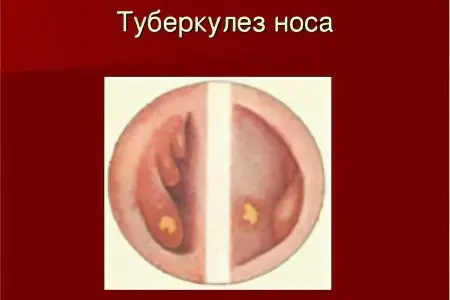
Tuberculosis of the nose is a chronic sluggish disease. Gradually, the patient has a deformation of all elements of the nose. Ulceration sites, painful nodules, infiltrates are formed in the affected area. Both the skin and mucous membranes suffer. A person begins to worry about regular nosebleeds. At the last stage of the development of the disease, the tissues of the nose melt, areas of necrosis, abscesses, and fistulas become visible. Bone and cartilage structures will be permeated through channels.
Tuberculosis is caused by Koch’s bacillus. This mycobacterium enters the nose from the primary site of infection. Initially, either the lungs or the bones are affected. Less commonly, nasal tuberculosis develops as a primary infection, when Koch’s bacillus in large quantities enters the damaged tissues of the organ.
herpes in the nose
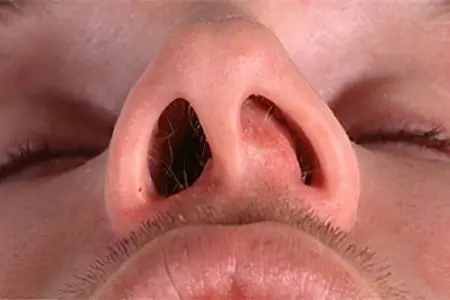
When a herpetic rash appears in the nose, a person will experience pain. Most often, the bubbles are located inside the nose, so the discomfort increases when you press on its wings. In addition to pain, a person will suffer from itching and burning in a characteristic area.
The herpes virus is activated with a decrease in immunity.
To provoke the appearance of rashes can be factors such as:
Subcooling the body.
Vitamin deficiency.
Exacerbation of chronic pathologies.
Iron-deficiency anemia.
Nose injuries.
If there is no treatment for herpes in the nose, then the viral infection can spread to the eyes. Rashes will appear on the conjunctiva.
Syphilis nose
Treponema pallidum is the causative agent of nasal syphilis. This infection enters the nasal cavity mechanically. Infection can occur when picking the nose with dirty fingers. Also, the infection can spread through the blood. Therefore, pale treponema can penetrate into the nasal cavity from the source of primary infection, which occurs in the absence of treatment, or when inadequate therapy is selected.
At an early stage in the development of the disease, a red patch of skin or mucous membrane forms in the nose. The affected area is characterized by soreness, tissues swell. Due to swelling and thickening of the mucous membranes, a person will suffer from nasal congestion. The multiplication of bacteria leads to the melting of the nasal passages. During this period, purulent discharge appears.
Charlina syndrome
With Charlin’s syndrome, a person has pain in the nose and in the area of uXNUMXbuXNUMXbthe eyeballs. They get stronger at night. Accompanied by a violation of mucous secretions from the nose.
Charlin’s syndrome develops against the background of neuritis of the nasociliary nerve. It is represented by the thinnest fiber that departs from the optic nerve. The impetus for the development of Charlin’s syndrome is inflammatory diseases of the mucous membranes of the nose, their injury, etc.
Ganglioneuritis (Slader syndrome)
Slander’s syndrome is characterized by inflammation of the pterygopalatine ganglion. This node is represented by nerve fibers that are responsible for the innervation of the nose. Therefore, a person has pain of the corresponding localization.
The pain is concentrated in the region of the bridge of the nose, in the region of the back of the nose, near its lateral walls. There are painful sensations like seizures that happen unexpectedly for a person. They last up to several days. In addition to pain, there is redness on the side of the face with which inflammation occurs. From the nose begins to allocate a transparent exudate.
Diagnosis of the causes of pain in the nose
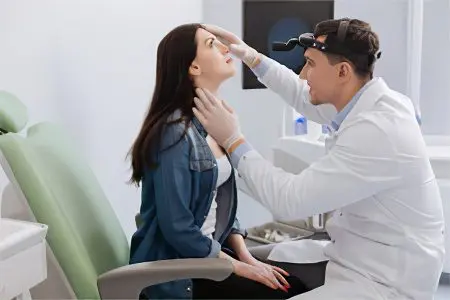
To find out the cause of pain in the nose, you need to contact an otolaryngologist.
The main diagnostic methods to establish the etiological factor of pain:
History taking.
Visual inspection.
Rhinoscopy.
Diaphanoscopy.
Endoscopy.
X-ray and CT.
MRI.
Ultrasound.
Microbiological examination to identify pathogenic flora.
Donating blood for a general analysis.
Anamnesis. The doctor is questioning the patient. He finds out how long he has been worried about pain in his nose, whether there are any other health problems, whether his nose was injured, etc. An analysis of the information collected suggests what caused the pain in his nose.
Visual inspection. During the examination, the doctor evaluates the color of the skin of the nose, the symmetry of its sides, its size, the presence of defects, areas of inflammation. Palpation allows you to clarify the location of pain, edematous areas, temperature of the skin.
Rhinoscopy. This study is carried out using a rhinoscope. The doctor can visualize the state of the internal nasal structures: the mucous membrane, turbinates, nasal septum. It is rhinoscopy that is the main method for diagnosing diseases of the nose.
Endoscopy. A study is performed using an endoscope. This device allows you to detect neoplasms in the nasal cavity. Endoscopy is used when the doctor needs to take tissue samples. The resulting material is sent for cytological examination.
Diaphanoscopy. This research method allows you to assess the patency of the sinuses in the presence of pathological neoplasms in them, for example, cysts. The procedure is carried out using a special device – a diaphanoscope.
Radiography. Performing radiographic images allows the doctor to obtain information about the state of the bone structures of the nose. Their location is assessed. If there are large neoplasms in the nose, then they can also be visualized on an x-ray. We are talking about cysts, hematomas and abscesses.
Magnetic resonance imaging and computed tomography. MRI and CT scans are used if the cause of the pain could not be identified using other examination methods. These diagnostic procedures provide maximum information about the condition of the nasal tissues, but their significant drawback is their high cost.
Ultrasonography. Ultrasound can diagnose inflammation of the paranasal sinuses, detect fluid accumulation in them, as well as neoplasms, if any.
Microbiological research. If the pain in the nose was provoked by an infectious flora, then a microbiological study allows you to establish which pathogen caused the inflammation. In the future, the doctor will be able to prescribe etiotropic treatment.
General blood analysis. Its results allow us to assess the composition of the blood, to establish the severity of the inflammatory reaction. OAC is prescribed to patients with infectious diseases, with a suspicion of a cancerous process.
Nose pain treatment

A patient with pain in the nose may be prescribed medical or surgical treatment. It all depends on the cause of their occurrence. Most often, discomfort is associated with respiratory diseases, which can be managed with the help of medicines.
Drugs that can be prescribed to the patient:
Palliatives. They will help to get rid of the symptoms of the disorder and improve the quality of human life.
Etiotropic drugs. They allow you to destroy the pathogenic flora, thereby ensuring the recovery of the patient.
Physiotherapy. These methods help to improve the nutrition of the affected tissues and accelerate their regeneration, stimulate the discharge of a viscous secret.
Normalization of the outflow of mucus from the nose can reduce the inflammatory response. For this, the patient is prescribed anti-inflammatory and decongestant drugs. Thick exudate liquefies and easily leaves the sinuses.
The doctor prescribes medicines after the causative agent of the infection is established. Viral disease is treated with antiviral drugs, and bacterial inflammation requires antibiotics.
Physiotherapy methods allow you to quickly cope with the inflammatory reaction and speed up recovery.
A patient with pain in the nose can be prescribed procedures such as:
Electrophoresis. Drugs enter the upper respiratory tract under the influence of electric fields. This allows you to reduce the intensity of the inflammatory reaction and accelerate the regeneration of the mucous membranes.
Phonophoresis. During the procedure, the patient’s body is affected by ultrasonic waves, which allow delivering the necessary drug to the deep parts of the nose. The study of the focus of inflammation accelerates recovery.
Amplipulse therapy. The physiotherapist works out the tissues of the nasopharynx with low frequency currents. This procedure has an analgesic and anti-inflammatory effect.
Breathing exercises can improve microcirculation in the sinuses. It’s not hard to do them. It is enough to alternately breathe either the right or the left nostril for 10 minutes. Repeat exercises at least 3 times a day. They allow you to saturate the blood with oxygen, so that the recovery processes are launched with a vengeance.
Surgery is resorted to when it is necessary to mechanically remove a pathological neoplasm in the nose. Sometimes the surgeon’s help is reduced to the restoration of damaged structures of the nose.
Indications for surgical intervention:
tissue abscess. The doctor aspirates pus from the nasal cavities, sanitizes them using antiseptics and antibiotics.
Hematomas. Surgical care is reduced to removing excess blood from the nasal cavity.
Injuries. The operation will be aimed at stopping the bleeding, at relieving pain and at correcting broken segments of the nose.
Foreign body in the nose. The doctor will try to remove the foreign object from the nasal passages as carefully as possible.
Nose cyst. During the operation, the pathological neoplasm is removed.
Anomalies in the structure of the nose. The surgeon’s help will be reduced to restoring the structures of the organ to generally accepted standards.
Tumor. Thanks to surgery, the doctor removes the pathological growth.
Carbuncle. During the operation, the doctor removes dead tissue and sanitizes the affected area.
Any purulent formations that appeared not only in the nose, but also next to it, should not be tried to squeeze out on your own. This can cause serious complications. First of all, this applies to boils and carbuncles.










වැටීමකදී නාසයේ වේදනාව සමග ඇතිවන හිසේ කැක්කුම පිලිබද පැහැදිලි කිරීමක් අවශ්යයි